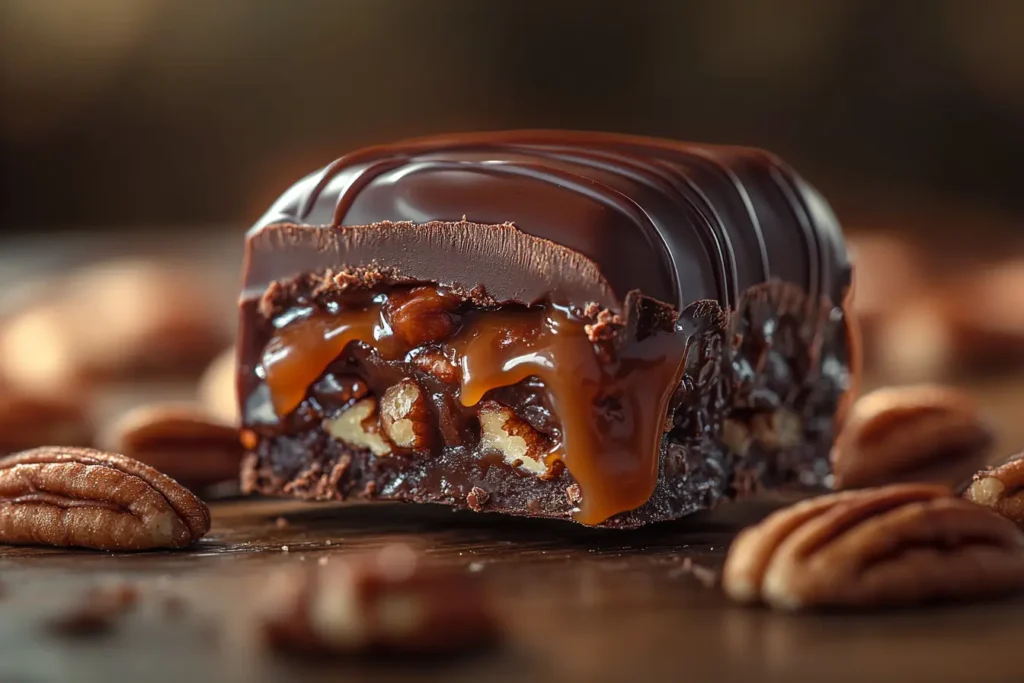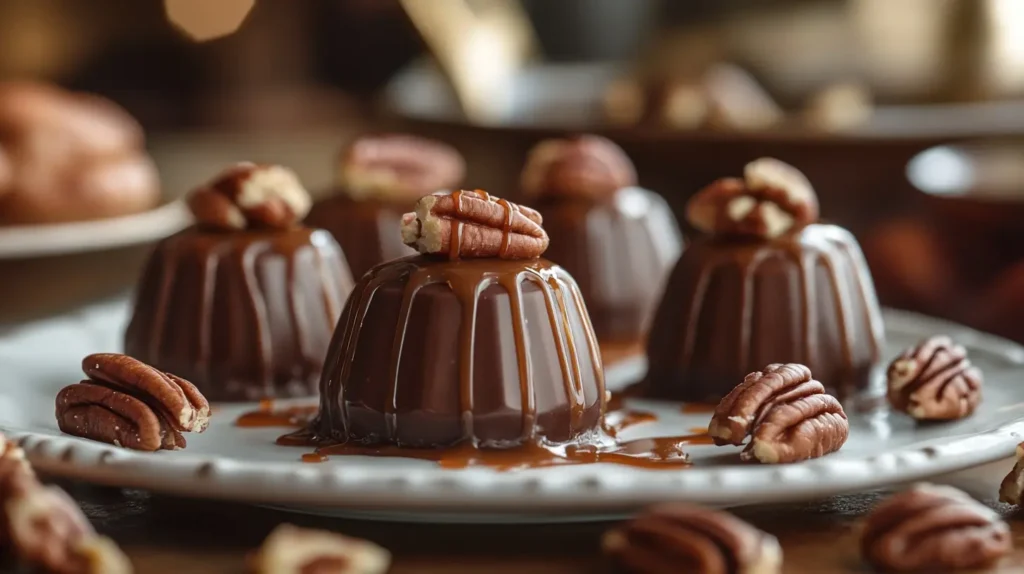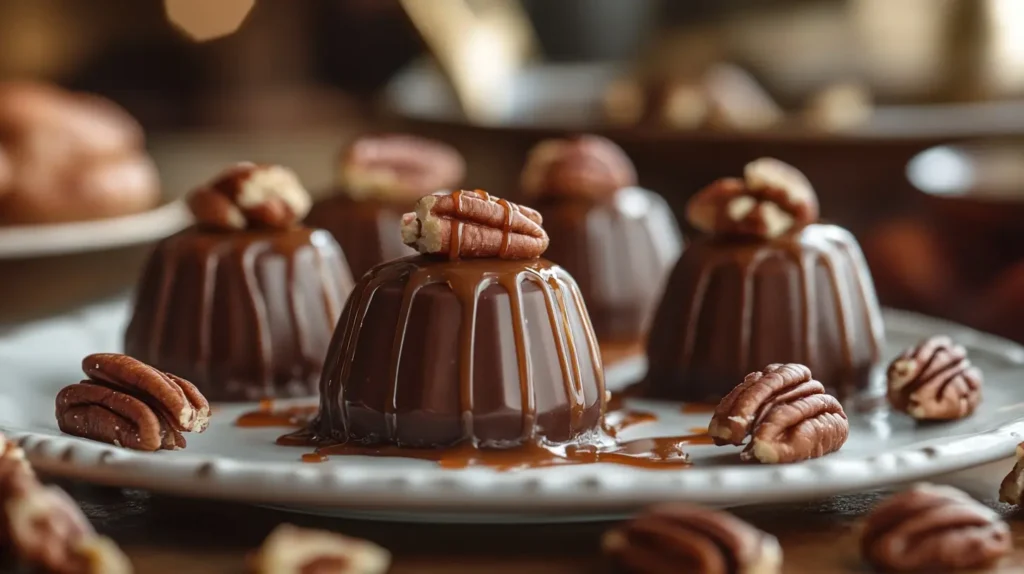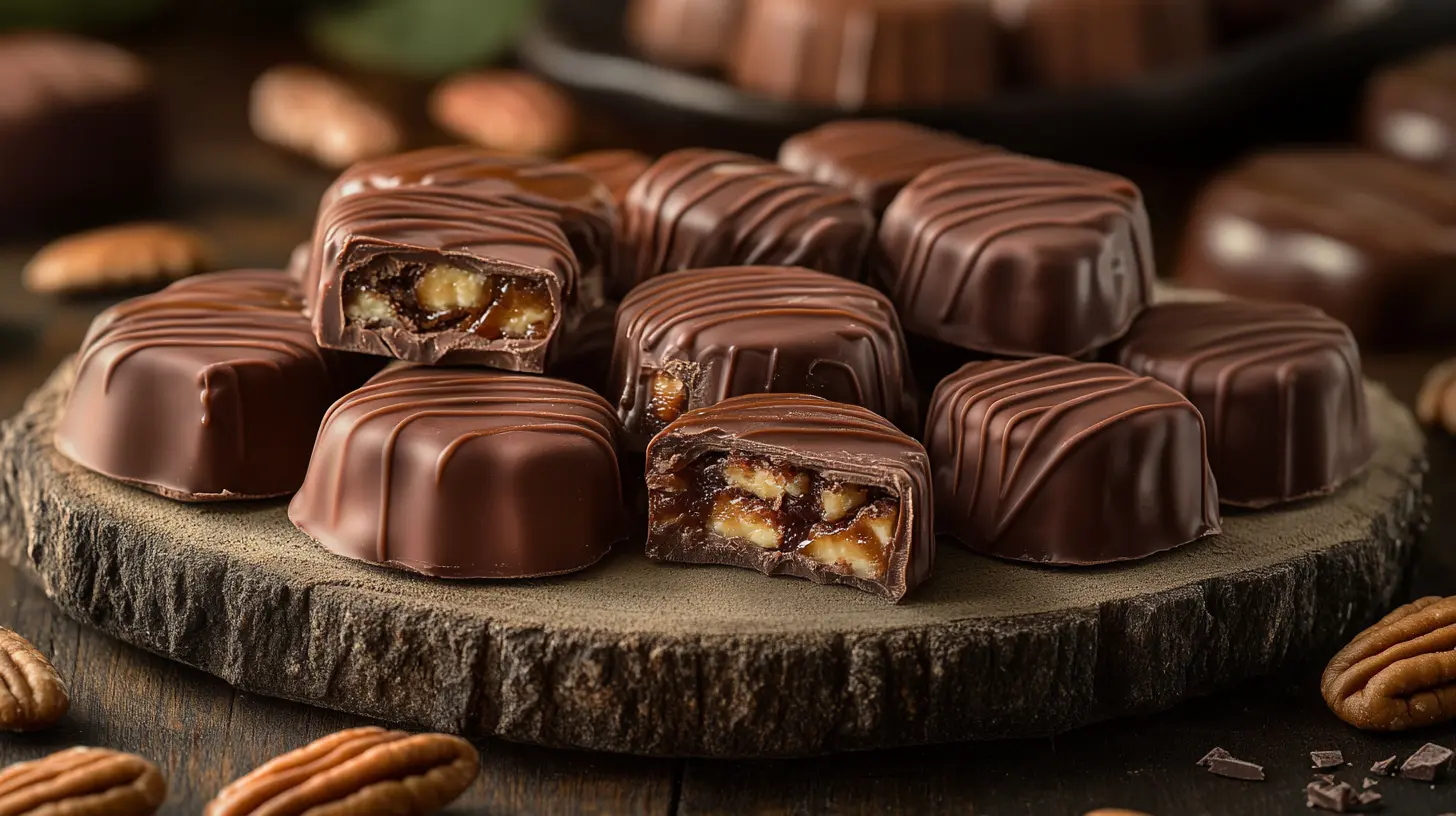Turtle chocolate is a delightful confection combining smooth chocolate, gooey caramel, and crunchy pecans into one heavenly bite. But what exactly does turtle chocolate taste like? Is it more nutty or sweet? This guide dives into every aspect of its flavor, texture, and versatility, offering insights for both curious tasters and chocolate enthusiasts. From its key ingredients to the way it compares with similar treats, we’ll break it down step by step, so you’ll know exactly what makes turtle chocolate so irresistible. Let’s unwrap the mystery of its taste, starting with its origins and popularity.
Understanding Turtle Chocolate
What Is Turtle Chocolate?
Turtle chocolate is a confection that combines chocolate, caramel, and pecans in perfect harmony. Shaped like a turtle’s shell, it earned its name because of its resemblance to the reptile when pecans stick out like little legs. It’s not just a candy; it’s an experience of flavor and texture.
A Peek into Its Origins
Turtle chocolate has been around since the early 20th century, with origins tied to candy makers in the United States. It was first crafted by the DeMet’s Candy Company, whose original recipe combined pecans, caramel, and chocolate, creating the iconic treat we know today. Over time, it gained massive popularity, becoming a staple at dessert tables and gift baskets everywhere. For an in-depth look at the history, recipes, and creative variations of chocolate turtles, check out our comprehensive guide here.
Popularity and Cultural Significance
Why is turtle chocolate so popular? The answer lies in its universal appeal—it satisfies those who crave something sweet, something nutty, and something indulgent. Plus, its versatility allows it to shine as a standalone treat or a star ingredient in other desserts, such as brownies or cheesecakes.
Turtle chocolate’s fame extends to festivals, where artisans craft gourmet versions with unique twists like dark chocolate, white chocolate, or even dairy-free options. Its enduring charm proves that simple combinations, done well, can stand the test of time.

Key Ingredients
The magic of turtle chocolate lies in its three key ingredients: pecans, caramel, and chocolate. Each component plays a unique role in creating the treat’s signature flavor and texture, working together in harmony to deliver a delightful experience in every bite.
Pecans
At the heart of turtle chocolate is the humble pecan. Known for their rich, buttery flavor, pecans add a nutty crunch that complements the sweetness of the caramel and chocolate. Their slightly earthy undertones balance the candy’s overall flavor profile, preventing it from becoming overly sweet.
Pecans also lend a unique texture to the treat, providing a satisfying crunch that contrasts with the softness of the caramel and the creaminess of the chocolate. Roasted pecans are often used to amplify their natural flavor and enhance their crispiness. In some variations, other nuts like almonds or walnuts might be substituted, but pecans remain the classic choice.
Caramel
The caramel in turtle chocolate is the glue—both literally and figuratively—that holds it all together. Sweet and chewy, caramel adds a luscious, gooey texture that melts in your mouth. Made from sugar, butter, and cream, it brings a rich, buttery sweetness that pairs perfectly with the crunch of the pecans.
The caramel’s sticky quality also helps bind the ingredients, ensuring the candy holds its iconic turtle shape. Whether soft or slightly firm, caramel is an essential component that brings warmth and decadence to every bite.

Chocolate
Finally, there’s the chocolate—typically milk chocolate, though dark or white varieties are often used in gourmet versions. The chocolate coating adds a creamy, smooth finish that wraps the other ingredients in a sweet embrace. Its rich cocoa flavor ties everything together, creating the perfect balance of nutty, sweet, and savory.
This trio of ingredients transforms simple flavors into an unforgettable confection.
Variations in Ingredients
The beauty of turtle chocolate lies not only in its traditional recipe but also in how easily it can be customized. By swapping or enhancing its key ingredients, bakers and confectioners can create countless variations that cater to different preferences or dietary needs.
Alternative Nuts
While pecans are the classic choice, other nuts can step in to offer new textures and flavors. Almonds, for instance, add a firmer crunch and a slightly sweeter note, making them a popular substitute. Walnuts, with their buttery and mildly bitter profile, can provide a bold twist to the traditional taste. For those seeking something unique, hazelnuts or macadamia nuts bring a rich, creamy texture that elevates the candy’s overall feel.
Additionally, nut-free alternatives like sunflower seeds or crushed pretzels can create a similar crunch for individuals with nut allergies, ensuring everyone can enjoy a version of this iconic treat.
Different Types of Chocolate
Chocolate is another area where creativity can shine. While milk chocolate is the standard, dark chocolate is often used for a deeper, slightly bitter flavor that complements the sweetness of the caramel. This variation appeals particularly to those who prefer less sugary confections.
On the sweeter end, white chocolate offers a creamy, buttery option that pairs beautifully with roasted nuts and caramel. Some gourmet recipes even incorporate flavored chocolates, like mint or salted caramel, to add another layer of complexity.
These ingredient variations prove that while the original turtle chocolate is timeless, there’s always room for innovation. Whether you prefer it classic or adventurous, there’s a version to satisfy every palate.
Taste Experience
Turtle chocolate is a delightful symphony of flavors, with each component contributing something unique. Its balance of sweetness, nuttiness, and caramel richness ensures every bite is a treat for the taste buds.
| Ingredient | Role in Turtle Chocolate |
|---|---|
| Pecans | Add a buttery, nutty flavor and a crunchy texture, balancing the sweetness. |
| Caramel | Provides gooeyness, a deep sugary flavor, and binds the candy together. |
| Chocolate | Wraps the candy in a creamy, smooth layer; complements the caramel and pecans. |
| Variations | Dark chocolate adds a rich, bittersweet note; white chocolate offers extra creaminess. |
Sweetness Level
The sweetness in turtle chocolate is rich but not overpowering, making it satisfying without being cloying. The milk chocolate typically used provides a creamy sweetness, while the caramel adds a deeper, almost buttery sugar note. Together, they create a layered sweetness that appeals to a wide range of palates. For those who prefer less sweetness, variations using dark chocolate offer a slightly bitter edge that contrasts beautifully with the caramel’s sugary profile.
Nutty Undertones
The pecans in turtle chocolate add a warm, nutty undertone that grounds the sweetness of the other ingredients. Their naturally buttery flavor blends seamlessly with the caramel and chocolate, creating a harmonious balance. When roasted, pecans take on a toasty aroma that enhances their nuttiness, adding depth to the overall flavor.
Caramel Notes
Caramel is the star ingredient when it comes to richness. Its slightly burnt sugar flavor provides warmth and depth that ties the candy’s taste together. The caramel offers a gooey, decadent sweetness with hints of butter and cream, making it the perfect complement to the crunch of pecans and the smoothness of chocolate.
Every bite of turtle chocolate delivers a layered taste experience, combining these three elements into an unforgettable flavor journey.
Texture Analysis
Beyond its flavor, turtle chocolate is loved for its irresistible texture. Each bite delivers a satisfying contrast of crunch, chewiness, and creaminess.
Crunchiness from Nuts
The pecans offer the candy its characteristic crunch, providing a delightful contrast to the softer elements. Their crisp texture is a welcome surprise amidst the gooey caramel and the melting chocolate, ensuring each bite has an enjoyable bite.
Creaminess of Caramel and Chocolate
The caramel’s gooey consistency brings a chewy, melt-in-your-mouth sensation that blends effortlessly with the velvety texture of the chocolate. Together, these two components create a smooth, creamy base that complements the crunch of the pecans.
This interplay of textures—crunchy, chewy, and creamy—is what makes turtle chocolate so satisfying. It’s a treat that feels as good to eat as it tastes, with every bite offering a medley of sensations.
Turtle Chocolate vs. Pecan Clusters
At first glance, turtle chocolate and pecan clusters might seem similar, as both feature pecans and chocolate. However, these two treats have distinct characteristics that set them apart.
Turtle chocolate is defined by its signature trio: pecans, caramel, and chocolate. The inclusion of caramel adds a gooey texture and a buttery sweetness that elevates the overall flavor. The caramel acts as the glue that binds the nuts together while offering a luxurious chewiness that is integral to the turtle chocolate experience.
In contrast, pecan clusters are a simpler treat, focusing primarily on the combination of nuts and chocolate. Typically, the pecans are coated or drizzled with melted chocolate, creating a crunchier, drier texture compared to the chewy, layered bite of turtle chocolate. Without the caramel, pecan clusters tend to be less sweet, making them a great option for those who prefer a more straightforward nut-and-chocolate flavor profile.
While both treats are delicious, turtle chocolate delivers a more complex flavor and texture, making it a more indulgent choice. Pecan clusters, on the other hand, shine in their simplicity, offering a crunchy, less sticky alternative.
Turtle Chocolate vs. Caramel Pecan Brownies
Turtle chocolate and caramel pecan brownies share some common elements but differ greatly in form, texture, and richness.
As a small, handheld candy, turtle chocolate is made by layering pecans, caramel, and chocolate. Its bite-sized nature makes it a quick, satisfying treat. Every bite offers a balance of crunch, chewiness, and creaminess. The flavor profile is sweet and nutty, with the caramel delivering a rich, buttery note that stands out.
Caramel pecan brownies, however, are a baked dessert with a dense, fudgy texture. They incorporate pecans and caramel into the brownie batter or as a topping, blending these ingredients with the rich, chocolaty base. The result is a decadent dessert that delivers a more intense chocolate flavor compared to turtle chocolate.
While turtle chocolate is light and easy to snack on, caramel pecan brownies are heavier and more filling, often served as a dessert rather than a quick treat. Both are undeniably delicious, but turtle chocolate appeals to those seeking variety in texture, while caramel pecan brownies are for chocolate lovers who enjoy a baked indulgence.
In Desserts
Turtle chocolate isn’t just a standalone delight; it’s also a versatile ingredient that elevates a variety of desserts. From cheesecakes to brownies, its combination of pecans, caramel, and chocolate adds indulgence to classic recipes.
Turtle Cheesecake
Turtle cheesecake is a decadent twist on the traditional cheesecake. The creamy base is often infused with caramel swirls and sprinkled with pecans for added crunch. A chocolate ganache topping, sometimes drizzled with caramel, gives it the signature turtle flavor.
Many recipes feature a pecan and graham cracker crust, which adds a buttery, nutty crunch that perfectly complements the velvety cheesecake filling. With every bite, you experience the layered richness of chocolate, caramel, and cream cheese. This dessert is a showstopper at gatherings, appealing to those who crave something both sweet and indulgent.

Turtle Brownies
Turtle brownies are a chocolate lover’s dream. These fudgy treats take the standard brownie recipe and elevate it by incorporating turtle chocolate flavors. Gooey caramel is swirled into the brownie batter, while pecans are folded in or sprinkled on top. A drizzle of melted chocolate or caramel creates a picture-perfect finish.
The result is a dessert that balances textures: the fudgy softness of the brownie, the crunch of the pecans, and the gooey richness of the caramel. Turtle brownies are perfect for those who love the flavor of turtle chocolate but want something warm and baked.
As a Standalone Treat
While turtle chocolate is a fantastic ingredient, it shines just as brightly on its own. The combination of pecans, caramel, and chocolate delivers a perfectly balanced bite-sized treat that’s hard to resist.
Its portability makes it ideal for snacking, whether enjoyed with a cup of coffee or shared as a sweet gift. Turtle chocolates are also popular in holiday assortments, appealing to kids and adults alike. Gourmet versions, featuring variations like sea salt or dark chocolate, add a touch of sophistication, making it a versatile treat for all occasions.
Sometimes, the best way to enjoy turtle chocolate is simply to savor it, one luscious bite at a time.
Homemade Recipes for Turtle Chocolate Flavor
Making turtle chocolate at home is not only a fun and rewarding activity but also lets you customize the taste of turtle candies to your liking. Whether you’re curious about what does turtle chocolate taste like in its classic form or eager to try creative variations, crafting these treats is a delightful project for anyone who loves candy-making.
Classic Turtle Chocolate Candies
Creating classic turtle chocolate candies is simple, requiring just a few essential ingredients: pecans, soft caramel, and melted chocolate.
- Arrange the Pecans for the Turtle Chocolate Base: Place small clusters of pecans (three or four per cluster) on a parchment-lined baking sheet. These clusters form the “legs” of your caramel nut chocolate candy.
- Add the Caramel for Gooey Turtle Chocolate Flavor: Melt soft caramels with a splash of cream to achieve a pourable consistency. Spoon the melted caramel over the pecan clusters to bind them together. Let the caramel cool and set.
- Coat with Chocolate for a Classic Turtle Chocolate Finish: Melt milk chocolate (or another variety) using a microwave or double boiler. Drizzle or spoon the melted chocolate over the caramel-pecan clusters, ensuring an even coat.
- Let the Turtle Chocolate Set: Allow the candies to cool completely before serving or gifting.
These homemade candies embody the flavor of turtle chocolates while being perfect for any occasion.
Variations and Tips for Pecan Caramel Chocolate Treats
Homemade turtle chocolates are endlessly adaptable:
- Experiment with Chocolate Types: Try dark chocolate for a more intense cocoa flavor or white chocolate for added creaminess.
- Explore Nut Alternatives for Unique Turtle Candy Flavors: Swap pecans with almonds, walnuts, or hazelnuts to give your treats a twist.
- Add Sweet or Savory Finishes: Sprinkle a touch of sea salt over the caramel for a salty-sweet contrast or decorate with crushed peppermint, sprinkles, or toasted coconut for a festive look.
Remember, the secret to perfect caramel nut chocolate treats lies in using fresh nuts and high-quality chocolate. With these variations and tips, you can craft the ideal turtle chocolate flavor at home, personalizing it to suit every occasion.
Frequently Asked Questions
Can I use different nuts in turtle chocolate?
Yes, you can! While pecans are the traditional choice for turtle chocolate, other nuts like walnuts, almonds, or hazelnuts can be used as substitutes. Each nut brings its own unique flavor and texture, allowing you to tailor the treat to your preference. For a nut-free version, you could try using seeds or pretzels to maintain the crunch.
Are chocolate turtles gluten-free?
Yes, most chocolate turtles are naturally gluten-free, as they are made with simple ingredients like nuts, caramel, and chocolate. However, always check packaging or ingredient labels to ensure there are no added gluten-containing fillers. For more on gluten-free foods, visit Healthline.
Why are chocolate turtles called Turtles?
The name “Turtles” comes from the shape of the candy. When the pecans are arranged and coated with caramel and chocolate, the finished candy resembles a turtle, with the pecans sticking out like legs and a head. The whimsical appearance is part of its charm!
Curious about why chocolate turtles got their unique name? Discover the fascinating history and fun facts behind these sweet treats here.
How to make chocolate turtles?
Making chocolate turtles is simple. Arrange clusters of pecans on a lined tray, add melted caramel to hold them together, and coat with melted chocolate. Let them cool and harden before serving. If you’re looking for a detailed, beginner-friendly tutorial on how to make chocolate turtles at home, check out this step-by-step guide here.
What are in turtle chocolates?
Turtle chocolates typically include pecans, caramel, and chocolate. These three ingredients are combined to create a rich, sweet, and nutty confection that is crunchy, chewy, and creamy all at once.
What is a turtle chocolate candy?
A turtle chocolate candy is a bite-sized treat made with a cluster of pecans coated in caramel and covered in chocolate. Its unique shape and delicious combination of flavors make it a popular dessert or gift. To learn more about what a turtle chocolate candy is, its history, ingredients, and some fun facts, check out this detailed article here.
How do you make homemade chocolate turtles?
Homemade chocolate turtles can be made by layering roasted pecans, melted caramel, and melted chocolate. Let the candies cool and set before enjoying. Customization options like adding sea salt or using different nuts make homemade versions even more fun.
Are chocolate turtles gluten-free?
Yes, most chocolate turtles are naturally gluten-free, as they are made with simple ingredients like nuts, caramel, and chocolate. However, always check packaging or ingredient labels to ensure there are no added gluten-containing fillers.
How to make chocolate caramel turtles?
To make chocolate caramel turtles, arrange pecans in clusters, drizzle melted caramel on top, and coat with melted chocolate. Let them set before serving. It’s an easy recipe that requires minimal ingredients and effort!
Summary of Turtle Chocolate’s Taste and Appeal
What does turtle chocolate taste like? It’s a treat that combines flavors and textures in perfect harmony, making it irresistible to candy lovers. The sweetness is rich but not overwhelming, with creamy caramel, smooth chocolate, and the buttery crunch of pecans coming together to create a balanced flavor experience. What does turtle chocolate taste like, you ask? It’s nutty, sweet, and slightly salty, all wrapped in a decadent chocolate coating.
The texture is just as enticing as the flavor. What does turtle chocolate taste like when you bite into it? The crunchiness of the nuts contrasts wonderfully with the gooeyness of the caramel, while the chocolate adds a velvety, melt-in-your-mouth creaminess. This interplay of chewiness and crispness is what makes every bite so satisfying.
Additionally, turtle chocolate’s versatility makes it even more appealing. Whether you enjoy it on its own, add it to brownies, or use it to top a cheesecake, it brings a unique twist to desserts. Curious about what does turtle chocolate taste like in a gourmet variation? Custom flavors like sea salt or dark chocolate add even more depth to this classic treat.
In the end, what does turtle chocolate taste like? It’s the perfect balance of sweetness, nuttiness, and creaminess that sparks joy with every bite, making it a timeless confection loved by all.

